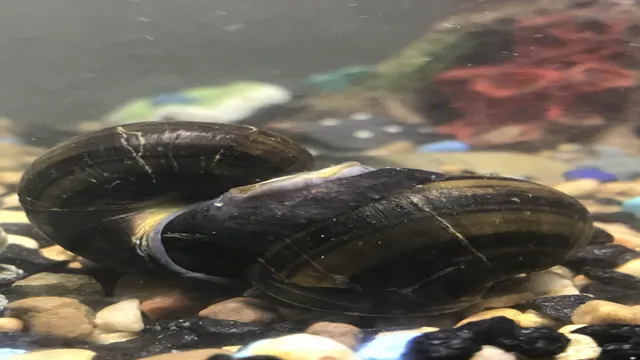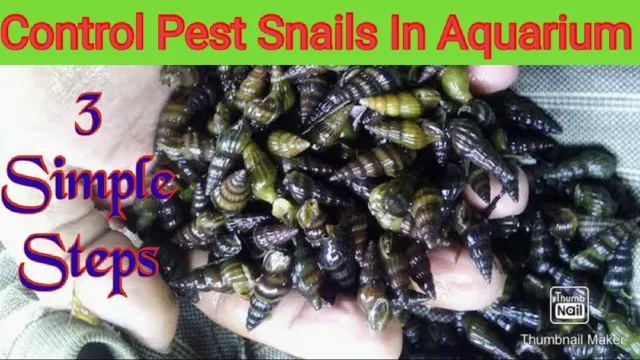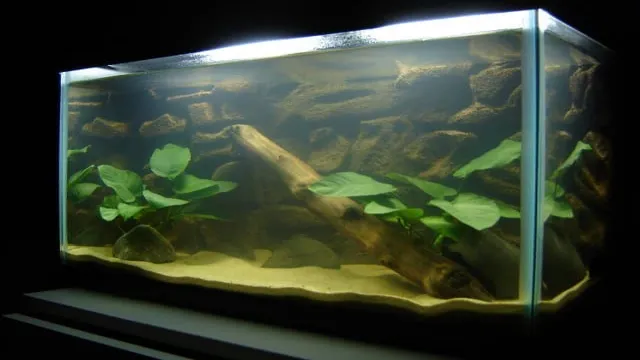Have you ever had a Mystery Snail get stuck in your aquarium filter? It can be a bit nerve-wracking trying to figure out how to free them without harming either the snail or the filter. But fear not, for there is a gentle and effective method to remove your snail from the filter. Similar to untangling a knot, it’s important to stay patient and careful throughout the process.
Rushing or using abrupt movements can potentially harm your snail or damage your filter. Instead, slowly and gently maneuver your snail out of the filter with a pair of tongs or a net. It’s also important to note that Mystery Snails are known for climbing up into filter tubes or boxes, so regularly checking and cleaning your filter can help prevent future snail mishaps.
In sum, freeing a snail from your aquarium filter can be a delicate process, but with patience and a gentle touch, both your snail and your filter can safely coexist.
Tools and Materials Needed
If you’ve ever had to remove a mystery snail from your aquarium filter, then you know it can be a tricky task. The last thing you want to do is harm the snail or damage your filter. Luckily, there are a few tools and materials you can use to gently remove a mystery snail.
Firstly, you’ll need a pair of tweezers that are long enough to reach into the filter. You can also use a net or a suction cup, depending on the size and location of the snail. Before attempting to remove the snail, make sure to turn off your filter to prevent any harm to your little friend.
If the snail is stuck onto the filter, try gently wiggling it back and forth until it comes free. If this doesn’t work, apply a small amount of vegetable oil or olive oil around the snail to loosen its grip. With a little patience and the right tools, you can successfully remove a mystery snail without causing any harm.
Net or Scoop
When it comes to harvesting hay, the two most commonly used tools are the net and the scoop. Both have their own unique advantages and disadvantages, and the choice ultimately comes down to personal preference and the specific needs of the farm. The net is a popular choice as it is easy to use and requires less manual labor.
However, it can also be more prone to tearing and can be difficult to manage in windy conditions. Additionally, if the hay is not spaced out correctly, there is a likelihood of spoilage. On the other hand, the scoop is better for those with limited space and is less likely to tear, making it a more durable option.
However, it requires more physical exertion and may not be recommended for farmers who are dealing with large amounts of hay. Ultimately, the choice between the net and scoop should be based on a combination of factors, including the size of the farm, the amount of hay that needs to be harvested, and personal preference.

Soft Brush
When it comes to using a soft brush, it is important to have the right tools and materials to achieve the best results. First and foremost, you will need a high-quality soft brush that is appropriate for the task at hand. Look for a brush that is made with natural bristles, as these are gentle on the surface being painted and will distribute the paint evenly.
Other tools that may be helpful include masking tape to protect areas that should not be painted and a mixing palette for blending colors. In addition, it is important to use high-quality, water-based paints that will not cause damage to the surface being painted. With the right tools and materials, you will be able to achieve beautiful and precise results when using a soft brush.
Gloves (Optional)
When it comes to woodworking, gloves are an optional accessory that can be beneficial in certain situations. If you are working with sharp objects, such as chisels or knives, gloves can offer an extra layer of protection. Additionally, if you are working with materials that may be harmful to your skin, such as chemicals or toxins, gloves can prevent skin irritation or other health problems.
However, it is important to note that gloves can also limit your dexterity and tactile sensitivity, which can negatively affect your ability to manipulate tools and materials. As such, it is important to assess the risks and benefits of wearing gloves before starting a project. Ultimately, the decision on whether or not to wear gloves should be based on your personal comfort and safety needs.
Step-by-Step Guide
Mystery snails can be fascinating additions to your aquarium. However, when they crawl onto the filter in your tank, it can be challenging to remove them without harming them. Removing a mystery snail off your aquarium filter should be done gently to avoid causing stress or harm. (See Also: How to Make a Fry Trap for Your Aquarium: A Step-by-Step Guide for Keeping Your Fish Safe and Healthy)
The first step is to ensure that you have unplugged the filter and wait a few minutes for it to stop running. You may then use your fingers or a soft brush to disengage the snail from the filter, carefully avoiding its antennae. Once you have freed the snail from the filter, return it gently to the substrate in the aquarium.
By following these steps, you can gently remove the mystery snail from your aquarium filter without causing any harm, allowing it to continue to thrive in your aquarium.
Step 1: Turn off the Filter
If you are struggling with poor water quality in your aquarium, the first step towards fixing the issue is to turn off the filter. You might be wondering why would you do the opposite of what you’ve been told to maintain clean water for your fish? Well, the filter could be the culprit behind the murky water. Turning it off would allow all the debris and waste to settle at the bottom of the tank.
This way, you can identify the cause of the problem and take appropriate steps to fix it. Perhaps the filter needs cleaning or replacement, or maybe the water conditions need adjusting. Whatever the issue may be, you will have a better idea once you turn off the filter and examine the state of your aquarium.
So, when in doubt, try turning off the filter and see if it makes any difference.
Step 2: Remove the Snail with Net or Scoop
Once you have identified a snail in your aquarium, the next step is to remove it using a net or scoop. This can be a bit tricky, as snails tend to move slowly and may hide in hard-to-reach areas. Start by slowly and carefully placing the net or scoop near the snail, being careful not to spook it or disrupt any other inhabitants of the tank.
Gently scoop the snail up and remove it from the water. It’s important not to be too forceful, as this can harm the snail and other living organisms in the tank. Remember to dispose of the snail properly, as simply throwing it in the trash may allow it to continue living and reproducing.
By removing the snail promptly and correctly, you can help maintain a healthy and balanced aquarium ecosystem. So, why not grab your net or scoop and get started?
Step 3: Brush the Snail Gently
After properly cleaning your snail, it’s now time to carefully brush it. Using a gentle bristle brush or soft toothbrush, start brushing the shell. It’s crucial to be as delicate as possible to not damage the snail’s shell.
Brushing too hard can cause cracks on the surface that can harm the snail’s skin. When brushing, start at the top and work your way down to the bottom of the shell. Don’t forget to brush the shells’ crevices and small curves.
These areas are prone to build-up of dirt and debris that can affect the snail’s health. Moreover, brush the snail’s foot gently, as it’s also prone to getting dirty. Clean your brush with water between strokes to avoid spreading dirt.
Brushing helps maintain the snail’s shell’s shine and removes any remaining dirt that might have clung to the snail even after cleaning it. Remember, a clean shell means a happy and healthy snail!
Step 4: Rinse the Snail in Water
After boiling the snail, the next step in preparing it for consumption is to rinse it in clean water. This is an important step because not only does it help to remove any debris or dirt that might be stuck to the snail, but it also helps to get rid of any excess salt that might have been used in the boiling process. To rinse the snail, simply place it under running water and use your fingers to gently rub away any remaining debris. (See Also: How to Be a Mermaid in an Aquarium: A Step-by-Step Guide to Transforming into a Sea Siren)
Be sure to rinse it thoroughly, until the water runs clear and there are no more traces of dirt or salt left on the snail. After rinsing, the snail is now ready to be seasoned and cooked to perfection. So, let’s get started and enjoy this delicious delicacy!
Step 5: Put the Snail Back in the Tank
After cleaning and acclimating your snail to its tank, it’s time to put it back into its home. Make sure to place the snail gently into the water and avoid dropping it from a high distance, as this can harm the snail’s shell. Some snails will immediately start exploring their tank while others may take some time to adjust.
Don’t worry if your snail isn’t moving around right away, as it may be getting used to its surroundings. Additionally, monitor the tank for any signs of stress or illness in your snail, such as lack of appetite or unusual behavior. Overall, putting your snail back into its newly cleaned tank signals the end of your cleaning journey and the beginning of a healthy and happy home for your pet.
Precautions to Take
Mystery snails are fascinating creatures to have in an aquarium. However, they can sometimes get stuck to the filter, which can be a problem for their safety and health. If you want to remove them, you have to do it gently to avoid damaging their shells or causing them harm.
First, turn off the filter to avoid any suction accidents. Then, use a pair of soft, silicone-tipped tongs to gently lift the snail off the filter. Avoid pulling the snail directly as this may damage its shell, and handle it carefully to prevent any injuries.
Once it’s removed safely, you can place it back into the tank. Always remember, never use force when handling your mystery snails or any other aquatic life in your aquarium. By taking these precautions, you’ll help to ensure the safety and well-being of your mystery snail, allowing it to continue to thrive in its home.
Avoid Exposing the Snail to Air for Too Long
When it comes to handling snails, it’s important to note that they are delicate creatures and require a bit of extra care. One thing to be mindful of is the amount of time that the snail is exposed to air. Snails need moisture to survive, and extended exposure to air can quickly dry out the skin and cause harm to the creature.
This is why it’s important to be quick when handling or transporting a snail. If you need to move it from one location to another, try to do so swiftly and avoid any unnecessary delays that could cause the snail to be unnecessarily exposed to the air. Additionally, you can provide a damp substrate or moistened bedding in the snail’s enclosure to help keep the humidity level at an appropriate level for the snail’s health.
By taking these simple precautions, you can help ensure the well-being of your snail and keep it happy and healthy.
Avoid Rough Handling of the Snail
As fascinating as snails are, they can be quite delicate creatures. Therefore, it’s essential to handle them with care and avoid rough handling. When handling snails, always make sure your hands are clean and dry, and never handle them with force.
If you need to move them, use a plastic spoon or a soft brush and avoid touching their delicate antennas. Rough handling can easily harm or even kill snails, so it’s crucial to exercise caution. Additionally, when transporting or storing snails, make sure to provide adequate ventilation and keep them moist.
By being mindful of how you handle and care for these unique creatures, you can ensure their health and well-being. Remember, snails aren’t toys, but amazing animals that deserve our respect and protection.
Avoid Disturbing the Filter Too Much
When it comes to maintaining an aquarium, proper filtration is one of the most important things you can do to ensure the health and wellbeing of your fish and other aquatic creatures. However, it’s important to be careful not to disturb the filter too much. This is because the filter is home to a delicate ecosystem of beneficial bacteria that help to break down waste and keep the tank clean. (See Also: How to Make an Aquarium Screen Cover: A Step-by-Step Guide to DIY Aquarium Screen Cover)
If you disturb the filter too much, you risk disrupting this delicate balance and harming the bacteria. To avoid this, be sure to follow the manufacturer’s instructions carefully when cleaning and maintaining your filter. It’s also important to avoid overfeeding your fish, as this can lead to excess waste and a greater risk of clogs and other filter problems.
By taking these precautions, you can help to ensure that your aquarium remains healthy, clean, and thriving for years to come.
Conclusion
Removing a mystery snail from your aquarium filter can be a delicate task, but with a little patience and finesse, it’s easy to accomplish without disturbing the delicate balance of your aquatic ecosystem. Whether you choose to use a soft-bristled brush or a gentle hand, the most important thing is to take it slow and steady, reminding yourself that snails, like all creatures great and small, deserve our respect and care.”
FAQs
What is the best way to remove a mystery snail from an aquarium filter without harming it?
The best way to remove a mystery snail from an aquarium filter is to turn off the filter and gently lift the snail out of the current using a net or your hands if you are comfortable. Make sure to handle the snail carefully and avoid pulling on its shell.
My mystery snail is stuck to the filter. What should I do?
If your mystery snail is stuck to the filter, do not attempt to forcibly remove it. Instead, turn off the filter and wait for the snail to detach on its own, which may take several hours. You can also gently prod the snail with a soft object, like a toothbrush, to encourage it to release from the filter.
Can I use chemicals to remove a mystery snail from my aquarium filter?
No, you should not use chemicals to remove a mystery snail from your aquarium filter. Chemicals can be harmful to the snail and to other organisms in the tank. It is best to rely on gentle physical methods for removing a snail from the filter.
What are some other ways to prevent mystery snails from getting stuck in the filter?
To prevent mystery snails from getting stuck in the filter, you can try adding a pre-filter sponge to the intake tube or using a filter with a lower flow rate. You can also check your filter regularly and remove any debris or snails as needed.
How often should I clean my aquarium filter to prevent snail buildup?
It is recommended to clean your aquarium filter every 2-4 weeks to prevent snail buildup and other potential issues. However, the frequency of cleaning will depend on the size of your tank, the number of inhabitants, and your filter type.
Are mystery snails harmful to aquarium filters?
Mystery snails themselves are not harmful to aquarium filters, but their buildup can cause clogs and reduce filter efficiency over time. It is important to keep an eye on the snail population and take steps to prevent them from causing problems in the filter.
Can mystery snails survive outside of water?
No, mystery snails cannot survive outside of water for very long. They require a humid environment to breathe and stay moist. If you need to remove a snail from the filter, make sure to keep it moist and return it to water as soon as possible.







